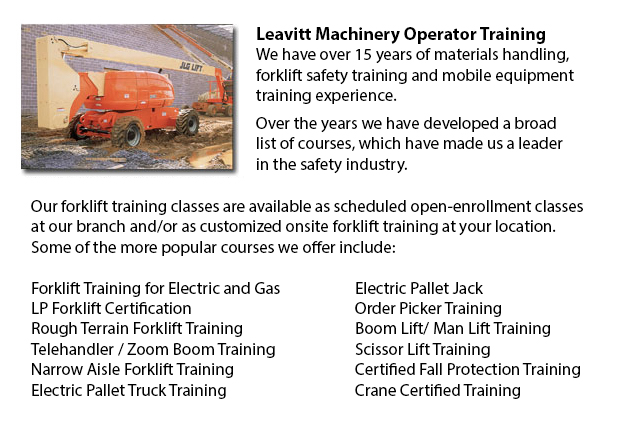
Manlift Safety Training Penticton - Manlift operators should be aware and cognizant of all the possible hazards that are associated with specific types of scissor lifts. They should be able to operate the scissor lift in a way that protects not only their own safety but the safety of those around them in the workplace.
The course offer its participants in-depth study in the following areas: Operator Evaluation on the equipment to be used, Safe Operation of Scissor Lifts and Manlifts, Safety Rules, Operator Qualifications and Legislated Requirements, The Requirements for Fall Protection Equipment, People, Equipment and Environment, Hazards Connected with the utilization of Manlifts and Scissor Lifts, Inspection of Fall Arrest Equipment and Pre-use Inspection of the Machinery, amongst other things.
Manlifts come in lots of different types, but are meant to meet the same fundamental needs, lifting things and employees to work areas that are far above the ground. Man Lifts are usually utilized in warehouses, retail stores, construction, manufacturing plants, for utility work and in any application where the work should be completed in a hard-to-reach location.
Types of Man Lifts
Manlifts are available in three major kinds: Boom Lifts, Personnel Lifts and Scissor Lifts. Intended particularly for single-users situations, personnel lifts are vertical travel buckets. They are the cheapest option for single-user operations which require just vertical travel. Scissor Lifts are flat platform machinery that travel straight up and down. These equipment are best utilized for moving large amounts of materials or people up and down. Scissor lifts offer more lifting capacity and larger workspaces than bucket lifts. Boom Lifts are buckets situated at the end of extendable or jointed arms. These machines are ideal if you need to reach up and over obstacles, since the majority of other machinery only move straight upward and downward.
Boom Lifts
Boom lifts come in two main varieties, the telescopic boom and the articulating boom lifts. The telescopic boom type is often known as a straight boom or a stick boom. This model has extendable and long arms which could reach up to 120' at virtually any angle. These booms are commonly used in the construction industry because their long reach allows staff to easily gain access to the upper stories of buildings. These are the best choice when the goal is getting the highest and longest reach.
The articulating boom has bendable arms that are capable of reaching around and over obstacles. These types of booms are normally called knuckle booms and could position the bucket into the exact location which it has to be. Articulating booms are common in the utility industry where working near obstacles like power lines and trees make positioning tricky. These booms are likewise common place in plant maintenance where they enable employees to reach over immovable machines.
Scissor Lifts
Scissor lifts just travel vertically, not like boom lifts. They generally provide bigger lifting capacities and larger platforms. These platforms offer more space for staff and materials, allowing employees to access a bigger work area without needing to reposition the lift. A kind of scissor lifts have a platform extension that provides a horizontal reach out of the top of the lift of 4' to 6'. Platform extensions offer a huge amount of flexibility even though overall scissor lifts are really limited compared to a boom lift.
-
Forklift Certification Schools Penticton
Forklift Certification Schools Penticton - In North America, forklift certification is mandatory, making forklift training programs essential for both the business and their employees working as operators of forklifts. Forklift training focuses on sa... More -
Telehandler Training Courses Penticton
Telehandler Training Courses Penticton - The employer has the responsibility to make sure that their personnel are trained to work proficiently utilizing telehandler machinery. The workers have to be assessed for their ability to utilize the machine.... More -
Certified Fall Protection Training in Penticton
There are many injuries at work linked to falling and lots of fall-related deaths reported each and every year. Most of these instances might have been prevented with better training, better precautions in place, and by properly equipping employees b... More -
Zoom Boom Training Penticton
Zoom Boom Training Penticton - Zoom Boom Training is designed to train operators on variable reach forklifts. The objectives of the training are to impart an understanding of the physics of the machine, and to outline the operator's job. This course... More -
Crane Training Schools Penticton
Crane Training Schools Penticton - We have designed various Mobile Crane Operation programs at our Crane Training Schools. These programs are recommended for the experienced operator who needs re-certification or certification, and for inexperienced... More -
Aerial Lift, Boom Lift, Man Lift, Scissor Lift Training in Penticton
Lift tables or also referred to as scissor hoists can lift up both individuals and materials vertically. They are normally utilized in industrial, construction and commercial environments. Normally, the use of a scissor forklift is to lift and lower... More -
Forklift Training Program Penticton
Forklift Training Program Penticton - The forklift is a common powered industrial vehicle which is in wide use nowadays. They are occasionally known as hi los, lift trucks or jitneys. A departments store will utilize the forklift to unload and load m... More -
Overhead Crane Training Penticton
Overhead Crane Training Penticton - An overhead crane is a large crane used to move and lift huge, heavy objects that cannot be lifted by hand. An overhead crane is normally fixed in position while in use. These machines are capable of moving huge vo... More

Forklift Training Penticton
TOLL FREE: 1-888-254-6157
Penticton, British Columbia
forklifttrainingpenticton.com
Email Us
About Us


